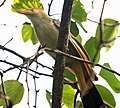Guira cuckoo
The guira cuckoo (Guira guira) is a gregarious bird found widely in open and semi-open habitats of eastern and southern Brazil, Uruguay, Paraguay, Bolivia, and northeastern Argentina.
| Guira cuckoo | |
|---|---|
| At the Pantanal, Brazil | |
| Scientific classification | |
| Kingdom: | Animalia |
| Phylum: | Chordata |
| Class: | Aves |
| Order: | Cuculiformes |
| Family: | Cuculidae |
| Genus: | Guira Lesson, 1830 |
| Species: | G. guira |
| Binomial name | |
| Guira guira (Gmelin, 1788) | |
 | |
Taxonomy
One of only four species within the subfamily Crotophaginae of the cuckoo family Cuculidae, G. guira is also the only species within the genus Guira.
Description
It is a rather scruffy-looking bird, with a total length of approximately 34 cm (13 in).[2] The sexes are very similar in appearance, except that the female is slightly larger than the male. Juveniles appear quite similar to adults.
The species has dark brown upperparts streaked with white, and whitish-buff throat, breast, underparts and rump. The tail is relatively long and broad, dark brown in color with a white-tip, and the legs are dark gray. The eyes and beak are yellow to orange, with a thin ring of featherless yellow skin around the eye (this commonly fades in captivity). There is a prominent orange-rufous crest.
Like other members of the subfamily Crotophaginae, the guira cuckoo gives off a strong, pungent odour.[3]
Behaviour
The guira cuckoo is a bird of open habitats such as pastures and wetlands, and its range has expanded significantly due to deforestation. Within its distribution, it is commonly seen in suburban parks and gardens. Like the related squirrel cuckoo, the guira cuckoo is not a particularly adept flier, and usually flies only for short distances. It is often seen gliding or hopping from one perch to another while vocalizating loudly. The bird's call is unmistakable for being long and shrill, something between a long whistle and a wailing.
Although it is primarily an arboreal bird, it is often seen foraging on the ground, sometimes alone but often in flocks of up to 18 individuals. It is sometimes seen with other birds whose behaviour is similar, such as the smooth-billed ani. Unlike many of the Old World cuckoos, the guira cuckoo does not practice brood parasitism or kleptoparasitism.
Feeding
_with_a_captured_frog.jpg)
The guira cuckoo is an opportunistic predator, gathering small prey items on the ground or searching for them among branches. It feeds on worms, insects and other arthropods, tadpoles and frogs, eggs, small birds (especially nestlings) and small mammals such as mice.[4] It also has been observed feeding on lizards.[5]
Nesting
The nest is built on a tree fork 2 to 5 m (6.6 to 16.4 ft) from the ground. The eggs (from 5 to 7) are dark green and covered with a chalky layer. They are incubated either in individual or community nests; in the latter one can find up to 20 eggs. Under community nests there are many broken eggs. The competition between young being great, mortality is significant.
References
- BirdLife International (2012). "Guira guira". IUCN Red List of Threatened Species. 2012. Retrieved 26 November 2013.CS1 maint: ref=harv (link)
- Payne RB (1997). "Guira Cuckoo (Guira guira)". p. 603. In: del Hoyo J, Elliott A, Sargatal J (editors). (1997). Handbook of the Birds of the World. Vol. 4. Sandgrouse to Cuckoos. Barcelona: Lynx Edicions. ISBN 84-87334-22-9
- Robert B. Payne; Michael D. Sorenson; Karen Klitz (2005). The Cuckoos: Cuculidae. Oxford University Press. p. 6. ISBN 0-19-850213-3.
- José Felipe Monteiro Pereira (2008). Aves e Pássaros Comuns do Rio de Janeiro. Rio de Janeiro: Technical Books. ISBN 978-85-61368-00-5. p. 71.
- Bernarde, Paulo Sérgio; Mota da Silva, Ageane; Recoder, Renato (2016). "Predation on the lizard Pantodactylus parkeri Ruibal, 1952 (Squamata: Gymnophthalmodae) by Guira guira (Aves, Cuculidae) in the Pantanal at Pocone, Western Brazil". Herpetology Notes 9: 279-281.
External links
- Guira at the Internet Bird Collection (IBC)
- Guiera at Zoo Basel / Switzerland Zoo Basel including map.
Gallery
| Wikimedia Commons has media related to Guira guira. |
 Wild individual in Brazil
Wild individual in Brazil At the National Aviary, Pennsylvania.
At the National Aviary, Pennsylvania._-Isle_of_Wight-8.jpg)
- in the Pantanal, Brazil
- in the Pantanal, Brazil
